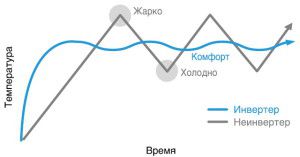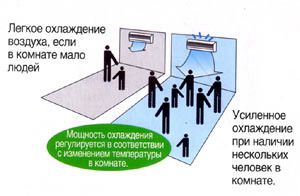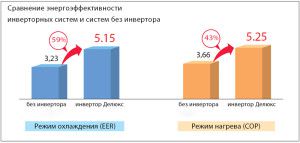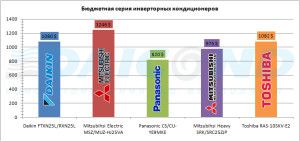Ten years ago, most buyers had no idea what inverter technology is and what advantages it brings to the consumer. Today, almost half of household and semi-industrial refrigeration machines are manufactured using just such progressive innovations in the design and management of the cooling device.
Nevertheless, many users still doubt when choosing which air conditioner is better: inverter or conventional, and what is their fundamental difference? Is it worth it to pay more than almost half, or all the hype surrounding the climate technology of such a plan is just a competent marketing move without a real advantage?
Differences between inverter split systems from conventional
First of all, it is worth understanding what the main differences are between conventional air conditioners, the so-called start-stop models, and inverters.
Principle of operation
The main difference is the principle of operation and the way to control the compressor functionality.
On / off air conditioners are designed so that their operation is based on on and off cycles. In order for the temperature ordered by the user to be reached, temperature sensors measure the room air at the start-stop split system and gradually accelerate the fan and compressor relative to the obtained parameters. As soon as the set parameters coincided with those obtained, the system automatically shuts down. When the elevations of the human-programmed marks are increased by more than 3 ° C, the appliance switches on again and begins to gradually cool the room.
Inverter-type air conditioners have completely different compressor control algorithms. After the temperature sensor has taken measurements, the compressor starts to rotate at high speed, reaching maximum power values, and sometimes even exceeding the nominal values by 15-20%. As soon as the desired temperature is reached, the unit switches to the slow-motion mode, in which the compressor rotates less frequently and the power is regulated smoothly. With an increase of 1 ° C, a slight acceleration of the compressor and an increase in power potential occur. Thus, the necessary temperature is constantly maintained in the room, but with different power.
The construction of an electric circuit by inverter air conditioning systems is based on two reciprocal stages:
- first, alternating current is converted to direct current;
- then the constant is converted back to variable.
It is due to the second stage that the compressor is slowed down and the power potential is regulated in a measured mode.
Power output range
Besides the difference in compressor control, how is the inverter air conditioner different from the usual one yet? From the first difference, the second also follows - the output power range.
On / off models have fixed (nominal) values of power potential, which remain unchanged during operation. If for the "nine" this figure is 2.5 kW, then it will also cool with such indicators. For air conditioners with an inverter type of drive, the power varies depending on the load. The range of the same “nine” can vary from 0.5 to 3.0 kW, on average having a rating of 2 kW. It turns out that the difference is not so much in the characteristics at peak loads as with integral ones.
From this we can conclude that an air conditioner with linear drive (on / off) is a device with constant cooling capacity, while an inverter one with a variable.
As a rule, the wider the output power range the inverter type air conditioner has, the more accurately the set temperature will be maintained in the room.
Energy Efficiency Class and Management Board
Another difference between an inverter air conditioner and a conventional one is an increased energy efficiency ratio. At some manufacturers, such as DAIKIN and MITSUBISHI ELECTRIC, it reached maximum levels of 4-5 kW.
All control algorithms are embedded in a stationary control board, which for inverter split systems is installed in an external unit. It is a complex set of electrical circuits that are responsible for the "intelligence" of the machine.
In addition to the board, inverter technology in air conditioners involves the availability of advanced compressors with a floating rotor or SCROLL compressors, as well as DC motors. More often in such units two types of motors are used: a permanent magnet electric motor in a compressor or direct current electric motors in fans.
Thanks to the intelligent board responsible for the entire operation of the device, the inverter-type air conditioning systems can be filled with a more original “filling” in the form of
- weather accounting functions;
- a complex system of self-diagnosis;
- protective mechanisms in case of power outages;
- extended operating temperature range for both cold and heat;
- various sensors for monitoring the movement of the remote control or a person in a room.
As a rule, it is the inverters that are equipped with a more complex cleaning system, which can include several stages of filtration:
- mechanical;
- electrostatic;
- absorption;
- bactericidal;
- photocatalytic.
Some manufacturers supply their climate technology with seven stages of filtration. Some detain visible particles of dirt, dust, wool, others disinfect the passing air, and others deodorize it. Although the same cleaning system can be equipped with any split start-stop type.
The whole essence of the rich functionality and optional features is that the inverter air conditioning systems look more advanced in comparison with their rivals, and the “bells and whistles” themselves, in fact, have no relation to the difference between start-stop and inverter models.
Advantages and disadvantages
With the main differences, everything became clear, but which air conditioner is better for the consumer: inverter or conventional, what are the positive qualities of both?
The first advantages are much greater than the second. These include a whole list of work features and the results obtained:
- Inverter machines reach the desired temperature much faster, since they can work for a short time in conditions of increased power exceeding the nominal values of cooling capacity indicated in the technical documentation;
- They more accurately maintain the temperature already achieved, since they have a wide range of output power;
- Such a split system never blows in the cooling mode with too cold air, while the on / off model at the beginning of operation produces flows with a temperature of 9-11 ° C;
- Since the fan motor and compressor make fewer revolutions, these devices almost do not make noise and do not vibrate;
- Inverter technology in air conditioners can significantly increase seasonal energy efficiency. Models with such compressor control can meet the latest European standards A +, A ++, A +++;
- The load on the network is significantly reduced, since inverters do not have large inrush currents when turned on;
- The wires of the power network are heated several times less;
- For models up to 18 kW, a single-phase power supply is used for cooling capacity;
- Due to the smooth increase in power and the absence of on / off cycles, a lesser degree of wear of the main working units is observed;
- If the air conditioner uses DC-inverter technology, then quite often the unit can work in winter in cooling mode to -20 ° C and heating to -15 ° C on the street.
The main disadvantage is the high cost of devices "stuffed" with an abundance of progressive electronics. Although in the process of functioning, such problems as breakdown of the control board and its expensive repair can occur. A common reason for the failure of this element is a higher sensitivity to the instability of the supply network than for start-stop models.
The choice
What to look for when choosing an inverter air conditioner, and in what cases is it necessary?
If a person acquires a cooling device according to the principle “it would not be hot / not cold”, then the usual split system is quite suitable for him. For those who care about the quality of the received cool / heat, worry about the noise level and do not allow the presence of different temperature zones in the room, it is better to pay attention to inverter models. Children's rooms, study rooms, bedrooms, rooms with non-standard shapes are places where it is better to install an inverter air conditioner rather than a start-stop one.
Where the refrigeration unit will operate around the clock, it is advisable to install an inverter. For commercial organizations with high electricity tariffs, it is also better to choose an inverter air conditioner - this will make it possible to save money due to seasonal energy efficiency.
If in the technical room, for example, in the server room, a further increase in the heat load is expected for the same area, then any climate technician will advise you to opt for an inverter air conditioning system, since it is it that makes it possible to gradually increase the capacity of server equipment.
When buying, pay attention not only to the rated cooling capacity, but also to the range of output performance. More extended borders guarantee high quality air treatment.
The decisive factors may be the manufacturer of climatic equipment and the price of the unit. Among the inexpensive inverter air conditioners, split systems have proven themselves well at the moment. Ballu, LG, MDV, Venterra, Hyundai. Even companies like MITSUBISHI ELECTRIC, DAIKIN, Toshiba, SHARP and Panasonic produce a line of cheapened splits of such a plan. The table below will provide examples of inexpensive models of inverter wall-mounted air conditioners from different brands with approximate prices of Yandex Market.
| Brand name | Series up to 30 thousand rubles | Series up to 50 thousand rubles |
| Ballu | ECO INVERTER | Platinum |
| LG | MEGA | Auro |
| MDV | R INVERTER | Vida |
| Hyundai | FORSAGE | ARMADA |
| Toshiba | SKSX | SKVR |
| DAIKIN | FTXN | FTXS |
Prices may vary depending on the unit size and the number of additional options ordered. It is worth considering that an inexpensive inverter air conditioner does not have as many small settings as a more expensive model.
Installation
Installation of any climatic equipment requires appeal to experienced craftsmen. Although the installation of inverter air conditioners is no different from the same actions with a start-stop split system, it is still not worth undertaking this task yourself, since the risk that all the electronics of such a capricious equipment will fail is very high.
The installation cost usually does not depend on the type of air conditioning drive. It is determined by such reasons as the size of the device, the need for a “hidden” installation, laying an additional route, installing anti-vandal devices, ordering a tower and carrying out high-altitude work.
Should I buy an inverter split system
The majority of users note in their reviews about inverter air conditioners that these devices:
- I work very quietly;
- qualitatively cool and heat the air;
- do not create different temperature zones;
- Do not cause problems with unnecessary spending on electricity;
- can be used in winter for heating in mild frosts;
- pay off their value for a couple of hot seasons.
We can say that inverter air conditioners, reviews of which are 99% positive, still outperform their start-stop competitors and are in great demand in the climate technology market.







